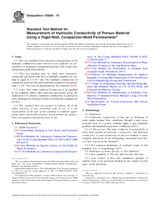Potřebujeme váš souhlas k využití jednotlivých dat, aby se vám mimo jiné mohly ukazovat informace týkající se vašich zájmů. Souhlas udělíte kliknutím na tlačítko „OK“.
ASTM D5856-15
Standard Test Method for Measurement of Hydraulic Conductivity of Porous Material Using a Rigid-Wall, Compaction-Mold Permeameter (Withdrawn 2024)
Automaticky přeložený název:
Standardní zkušební metoda pro měření hydraulická vodivost porézního materiálu Použití tuhého zdi , utužování - Mold permeametr
NORMA vydána dne 1.6.2015
Informace o normě:
Označení normy: ASTM D5856-15
Poznámka: NEPLATNÁ
Datum vydání normy: 1.6.2015
Kód zboží: NS-611285
Počet stran: 9
Přibližná hmotnost: 27 g (0.06 liber)
Země: Americká technická norma
Kategorie: Technické normy ASTM
Kategorie - podobné normy:
Anotace textu normy ASTM D5856-15 :
Keywords:
coefficient of permeability, groundwater, hydraulic barriers, hydraulic conductivity, liner, permeameter ,, ICS Number Code 19.060 (Mechanical testing)
Doplňující informace
| Significance and Use | ||||||||||||||||||||
|
4.1 This test method applies to one-dimensional, laminar flow of water within laboratory-compacted, porous materials such as soil. 4.2 The hydraulic conductivity of porous materials generally decreases with an increasing amount of air in the pores of the material. This test method applies to porous materials containing little or no air. The test method is designed to minimize the amount of air in the test specimen. However, this test method does not ensure complete saturation of the test specimen with water. In cases where it is essential to saturate the test specimen fully with water, the compacted specimen may be tested using Test Method D5084. 4.3 This test method applies to permeation of porous materials with water. Permeation with other liquids, such as chemical wastes, can be accomplished using procedures similar to those described in this test method. However, this test method is only intended to be used when water is the permeant liquid. 4.4 It is assumed that Darcy's law is valid and that the hydraulic conductivity is essentially unaffected by hydraulic gradient. The validity of Darcy’s law may be evaluated by measuring the hydraulic conductivity of the specimen at three hydraulic gradients; if all measured values are similar (within 25 %), then Darcy’s law may be taken as valid. However, when the hydraulic gradient acting on a test specimen is changed, the state of stress will also change, and, if the specimen or pore fluid is compressible, the volume of the test specimen or pore fluid will change. Thus, some change in hydraulic conductivity may occur when the hydraulic gradient is altered, even in cases where Darcy’s law is valid. 4.5 One potential problem with this method of testing is the possibility that water will flow along the interface between the test specimen and the compaction/permeameter ring. The problem tends to be of minimal significance for materials that swell when exposed to water (for example, compacted, clayey soils) but can be a very serious problem for materials that might tend to shrink and pull away from the walls of the permeameter. Test Method D5084 is recommended for any material that tends to shrink when exposed to the permeant liquid. 4.6 The correlation between results obtained with this test method and the hydraulic conductivities of in-place, compacted materials has not been fully investigated. Experience has sometimes shown that flow patterns in small, laboratory-prepared test specimens do not necessarily follow the same patterns on large field scales and that hydraulic conductivities measured on small test specimens are not necessarily the same as larger-scale values. Therefore, the results should be applied to field situations with caution and by qualified personnel. Note 1: The quality of the result produced by this standard is
dependent on the competence of the personnel performing it, and the
suitability of the equipment and facilities used. Agencies that
meet the criteria of Practice D3740 are generally considered capable of
competent and objective testing/sampling/inspection/etc. Users of
this standard are cautioned that compliance with Practice
D3740 does not in itself
ensure reliable results. Reliable results depend on many factors;
Practice D3740 provides a
means of evaluating some of those factors.
|
||||||||||||||||||||
| 1. Scope | ||||||||||||||||||||
|
1.1 This test method covers laboratory measurement of the hydraulic conductivity (also referred to as 1.2 This test method may be used with laboratory-compacted specimens that have a hydraulic conductivity less than or equal to 1 × 10−5 m/s. The hydraulic conductivity of compacted materials that have hydraulic conductivities greater than 1 × 10−5 m/s may be determined by Test Method D2434. 1.3 Units—The values stated in SI units are to be regarded as the standard, unless other units are specifically given. By tradition in U.S. practice, hydraulic conductivity is reported in cm/s, although the common SI units for hydraulic conductivity are m/s. 1.4 This standard does not purport to address all of the safety concerns, if any, associated with its use. It is the responsibility of the user of this standard to establish appropriate safety and health practices and determine the applicability of regulatory limitations prior to use. |
||||||||||||||||||||
| 2. Referenced Documents | ||||||||||||||||||||
|
Doporučujeme:
Aktualizace technických norem
Chcete mít jistotu, že používáte pouze platné technické normy?
Nabízíme Vám řešení, které Vám zajistí měsíční přehled o aktuálnosti norem, které používáte.
Chcete vědět více informací? Podívejte se na tuto stránku.




 Cookies
Cookies
